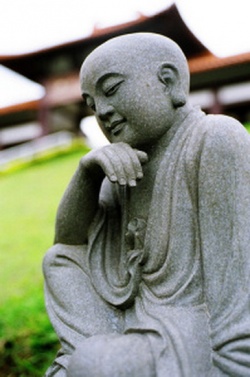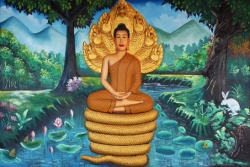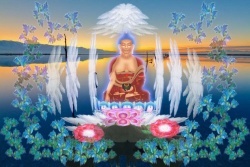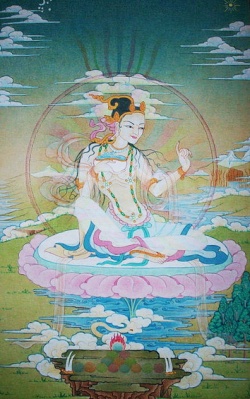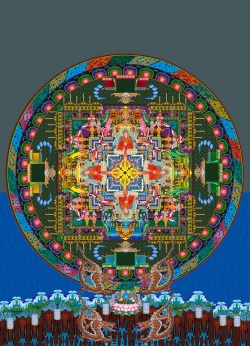The View of Consciousness-only And the View of Middle Way
Question(15): Buddhist schools, such as Tian-tai and Hua-yan in Han buddhism, generally take the view of the emptiness of the prajna Madhyamaka (Middle Way) as the basic view of Mahayana buddhism, while taking the view that “all sentient beings are endowed with the buddha nature, all can attain buddhahood” that is articulated in the Nirvana Sutra,
as the perfect teaching of Mahayana buddhism.
However, in Tibetan buddhism, it seems that the view of Middle Way is considered to be the highest view.
Yet, according to Han buddhism, the view of the emptiness of the prajna, and that all sentient beings can attain buddhahood, are two views of different levels.
What I would like to know is – guided by the view of Madhyamaka (Middle Way), how does Tibetan buddhism combine the intentions, or connotations, of the two different levels into the view of the emptiness of the prajna Madhyamaka?
Answer: All the schools in Tibetan buddhism agree, unanimously, that the highest view within Sutrayana is the view of Madhyamaka (Middle Way); the assumption that the highest view of Han buddhism is the view of Consciousness-only, and that only Tibetan buddhism takes the view of Middle Way as the highest view – this assumption is really an indicator of not having understood the doctrine of buddhism.
To judge which view is superior: the view of Consciousness-only, or, the view of Middle Way – the answer is not derived from geographic differences, such as whether this view comes from the Han region, or from the Tibetan region, but should be derived from buddhist scriptures, which is the sole gauge for discerning the ultimate view.
It is precisely out of scriptural evidence, and logical evidence, that Tibetan buddhism concludes that the view of Middle Way is the highest view within Sutrayana.
The lineage transmission of Madhyamaka, in the Tibetan region, all stems from Bodhisattva Nagarjuna, who has explicitly elaborated the real intentions of the Buddha.
And Bodhisattva Nagarjuna was a great bodhisattva, prophesied by Buddha Shakyamuni himself, where the Buddha articulated that, after his nirvana, Bodhisattva Nagarjuna would be the bodhisattva who had fully comprehended the definitive meaning of the buddha-dharma, and who could propagate the teachings of the sacred path.
In the Lankavatara-Rata Sutra, the Conqueror (the Buddha) prophesied that:
“At Vedabha in the south, there will be the renowned Bhikshu Shiri(or Bhikshu Wriman) known by the name of Naga, who will pulverize the extremes of existence or non-existence, and propagate my teachings of the unsurpassed Vehicle throughout the world; he will, after attaining the Pramudita stage(the first of the ten-bhumis of bodhisattvas), be reborn in the Pure Land(Sukhavati).
And in the Great Cloud Sutra (Mahamegha Sutra), Buddha says that: “400 years after my nirvana, this boy will be reborn as a bhikshu, known by the name of Naga, who will widely propagate my teachings, and afterwards, become Buddha in the Perfect Pure Light Land, named as Tathagata Jbanakaraloka (Buddha Wisdom Born Light), Arhat Samyak-Sambhudha.”
The original Madhyamaka (Middle Way) view in Tibetan buddhism comes directly from Bodhisattva Nagarjuna – the one prophesied by the Buddha – and was further developed and elucidated by other great bodhisattvas, successively, such as his disciple Candrakīrti, and passed all the way down to today.
When exoteric Sutrayana buddhism is discerning the highest view, no matter whether it is faced with the view of Consciousness-only, or the view of tathagatagarbha as stated in the third turning of the wheel of Dharma by the Buddha,
it must be clear that all these teachings, and views, are teachings that the Conqueror gives to various sentient beings with different predispositions and aptitudes.
When assessed from the ultimate level, both the consciousness asserted by the Yogacara Consciousness-only school, and the doctrine of tathagatagarbha stated in the third turning of the wheel of Dharma, should be understood as the great emptiness by its intrinsic nature, devoid of any conceptual-proliferation(papañca) or forms of real existence.
As it is recounted in the Lankavatara Sutra: “Like a doctor giving various medicines to different patients,
the Buddha, too, speaks of consciousness to sentient beings.” In Samādhirāja-sūtram, it mentions that:
“One must know that sutras, in which the Sugata teaches the emptiness, are where the definitive meaning is told; sutras, in which the cyclic existence of sentient beings is told, are teachings of the non-definitive level.”
If we explore further and deeper, we will realize that the coverage of tathagatagarbha can be really vast, sometimes the alaya-consciousness and the five great elements were also called tathagatagarbha;
for instance, in the Ghana-vyūha-sūtra, it propounds that:
“The alaya of earth, etc., are also the tathagatagarbha; The Buddha says that the tathagatagarbha is conceptualized in the name of alaya; And those with shallow-wisdom do not understand, that the garbha is nominally designated as alaya-consciousness.”
Judging from these statements, the view of Consciousness-only cannot be higher than that of the Middle Way, because when the major treatises (śāstras) of the Consciousness-only, such as Vijnaptimatratasiddhi Sastra,
and Triṃśikā-vijñaptimātratā (Thirty Verses on Consciousness-Only), are discerning the nature of dharmadhatu, they all agree that the nature of the mind is pure, luminous, and of real existence.
The concept of the mind’s nature being truly existent, when discerned with the ultimate or absolute truth, definitely does not accord with the real intentions of the Buddha. Because in Sutra of Prajna-Paramita in One-hundred Thousand Verses, the Buddha clearly mentions that:
“Subhuti, if someone has a clinging to terms and conceptuality, even as little as the tip of a hair, this person does attain the ultimate buddhahood.”
In Sutra of the Introduction to the Two Truths, it is also recounted that: “Deva, if in the ultimate reality, the real absolute truth is stated, in its nature, as a realm where there is the performance of the body, speech, and mind, that statement is not the absolute truth, but is of the conventional truth. Deva!
In the ultimate reality, the real absolute truth is beyond all speech and concepts, with no difference, no existence, no cessation, and no veering to that there being a speaker, or something being spoken, and that there being a knower, or something being known.
Deva! The real absolute truth surpasses the realm of all excellent appearances, all wisdom, and is not as the real absolute truth being spoken. All phenomena are illusory and deceiving. Deva!
The real absolute truth cannot manifest (itself), why not? Because all that there be a speaker, that something is being spoken, or someone for whom it is spoken, are, in the ultimate reality, non-existence; the non-existence cannot deliver non-existence.”
Therefore, if we want truly to discern the Buddha’s real wisdom, we must pulverize all conceptual-proliferation (papañca), or views clinging to real existence, and when approaching the tathagatagarbha, or the nature of the consciousness, we should also conform to this criterion.
In the Han region, books on Madhyamaka theories, introduced and recommended by great master Xuan-zang and his successor Master Kui-ji, were not many; besides the Root Verses on the Middle Way (Mūla-madhyamaka-kārikā),
Treatise on the Twelve Gates (Dvāda-śanikāya Śāstra), and A Hundred-Verse Treatise (Śata śāstra), the other Madhyamaka books, translated and commented by them, were very few.
Throughout their life, the view that they made efforts to propagate, was the view of Consciousness-only. With the rising, in contemporary and modern times, of Fa-xiang Consciousness-only (a subsidiary of Yogacara school), the view of Consciousness-only has again drawn wide attention from people.
Some people think the view of Yogacara Consciousness-only stands for the highest view within Sutrayana, but this assumption does not conform to the Buddha’s ultimate teaching.
We must, with reference to the absolute, definitive theories, discern the “real-existent, non-empty” section of the Consciousness-only view, to be the emptiness; and at the same time, we need to understand that this emptiness does not mean sheer emptiness, voidness, discontinuity (of karma) or annihilation, but means the dharmadhatu wisdom free from the eight extremes.
Bodhisattva Nagarjuna has elucidated:
“I prostrate to the most sublime of speakers, the completely-awakened one, who taught the sacred Dharma of cause and condition – no cessation, no birth; no permanence, no annihilation; no identity, no difference; no coming, no going – that leads to the relinquishing of all views (or conceptual-proliferation, papañca).” Therefore, the view of Middle Way should be the highest view within Sutrayana.
When measuring which one of the two views is the higher, one should not take his or her own conceptualized thoughts as the judging criteria, but should apply comprehensive discernment, solely in reference to sutras where the definitive or absolute meaning is told, and to treatises made by arya bodhisattvas.
It is because the relationship between the tathagatagarbha and the prajna emptiness is far beyond the sensory perceptions of the mortals; only through scriptural evidence, logical evidence, that the real meaning of “manifestations and emptiness are oneness” can be understood.
Relatively speaking, buddhist colleges in the Han region usually do not widely propagate the Madhyamaka teachings, therefore, we do wish that all the buddhists in the Han region, after having learned the Consciousness-only approach, would begin studying Madhyamaka,
and eventually realize the secret meaning of Middle Way. For detailed corroborative elaborations on why the view of Middle Way is higher than the view of Consciousness-only,
readers can refer to bodhisattva Candrakirti’s Introduction to the Middle Way (Madhyamakāvatāra) , great commentator Shantarakshita’s Ornament of the Middle Way (Madhyamakālaṃkāra), and Je Tsongkhapa’s treatise:
Elucidation of the Intention on ‘Introduction to the Middle Way (Candrakirti’s Madhyamakāvatāra)’. After a careful reading, contemplating, analyzing and discerning,
I believe that you will come to understand the Buddha’s compassion and real intentions in expediently giving teachings on Consciousness-only, and finally leading all practitioners into Middle Way – which are the learning stages, in accordance to the intentions of the Sage.
We also hope, therefore, that all the venerable masters and intellectuals in the Han region would not stick merely to the doctrinal stance of Consciousness-only, and refuse to go further to the study of Middle Way;
if you can delve into the Middle Way theories, along with a paralleled study on Buddha Shakyamuni’s sutras of the absolute truth, you will be aware of the supreme meaning of Middle Way.
Guided by the view of Middle Way, it would be very easy to combine the view of tathagatagarbha and the emptiness. Not admitting that the tathagatagarbha is concretely existent, and, believing that it is devoid of any conceptual-proliferation (papañca),
will help us, effortlessly, to comprehend the true meaning of Middle Way; yet, if one sticks stubbornly to the assumption that tathagatagarbha is, by nature, concretely existent, explaining any phenomenon (dharma) would not eventually help him or her to realize completely the ultimate reality of all phenomena.
Therefore, we need to know that all the definitive canons, such as: the exoteric manifestations and the emptiness are oneness; all phenomena are equal – are nectars of the precious buddha-dharma that have been experienced and realized by Buddha Shakyamuni himself, and should be greatly cherished.
In Mahaparinirvana Sutra, the Buddha again re-affirmed the absolute view of tathagatagarbha: “tathagatagarbha means that the intrinsic nature of buddha is pure, beyond any transition or change.
If someone says ‘exist’, the wise should be on guard against attaching to it; if someone says ‘not exist’, it is a false statement, the ignorant take it as sheer emptiness (or the discontinuity of karma), and are unable to grasp the real meaning of tathagatagarbha.
When it comes to the question of suffering, the ignorant do not understand that there is also the nature of great bliss in the body, they think that the body is non-eternal, like porcelain; the wise analyze this, and do not say that all is non-eternal.
Why not? Because one’s body is endowed with the seed of buddha nature. The ignorant cling to the idea that all buddha-dharma is non-self; the wise believe that non-self is merely a dependent designation of the mind itself, with no concrete existence, and knowing this, one should not have any doubt.
When the tathagatagarbha is stated to be empty, the ignorant, on hearing this, think of cessation or extinction; the wise understand that the tathagatagarbha is beyond transition or change.
If emancipation is stated as illusory, the ignorant think that emancipation is magic (where one wears away to nothingness); the wise analyze and understand that tathagata is supreme, like a ‘lion’ of men, is eternal and unchanging.
If it is stated that ignorance resides in all things, and as a result, there is the formation of karma, the ignorant hear this and think of two different existences: the ‘enlightened’ and the ‘un-enlightened’; the wise see that the intrinsic nature is not dualized. If one reads the intrinsic nature as non-dualized oneness, it is the real nature.
If it is stated that the formation (of karma) causes the consciousness of the next life, the ignorant cling the formation and the consciousness as two things; the wise see that the intrinsic nature is not dualized. If one reads the intrinsic nature as non-dualized oneness, it is the real nature.
If it is stated that all things have no self, and the essence of tathagata has no self, either, the ignorant cling them as two things; the wise know that the intrinsic nature is not dualized, which means that self and no self are, by nature, non-dualized oneness.
All the buddhas, the Conquerors, praise the unfathomable, boundless meaning of tathagatagarbha; I, too, have widely explained this in excellent sutras.”
This paragraph has explicitly elucidated the non-eternal, non-ceasing, non-existent, non-inexistent attributes of tathagatagarbha, as well as its relationship with emptiness—harmonious oneness.
At the same time, Buddha Shakyamuni has also instructed all practitioners, untiringly, that upholding this harmonious, comprehensive, definitive approach towards all buddha-dharma issues, is a must, otherwise, we would only wind up like the ignorant mentioned above – knowing only one side of the coin, but nothing of the other; having seen the trees, but missing the whole of forest; merely looking at words, but failing to catch the meaning; grasping just one point, but losing all the others.
It is from this perspective that we believe that what Master Ji-qun has just mentioned – “the view of the emptiness of prajna, and the view that all sentient beings can attain buddhahood, are views of two different levels” – echoes and coincides precisely with the approaches of some Tibetan buddhist schools.
For instance, the Gelug school holds the view of Madhyamaka emptiness, which is also known by the name of Rongtong (‘empty of self’), as the highest view; while the Jonang school extensively elucidates the virtue of tathagathagarbha, so their view is also known by the name of Shentong (‘empty of other’).
Actually, the distinction between these two schools is merely of a pedagogical nature; with regard to the view of the ultimate truth, they show no difference.
If one has read the elucidations on Middle Way, written by Je Tsongkhapa (Gelugpa master) and Je Tāranātha (Jonangpa master) respectively, one will have a very clear and comprehensive understanding of this issue.
The lord of Nyingma school, omniscient Mipham Rinpoche, concludes that: “All the schools, which hold the view of emptiness as the highest view, discern the nature of phenomena through the valid cognition of manifestations and emptiness; all the schools,
which state that buddha-nature is eternal, beyond transition and change, and that tathagatagarbha is truly existent, discern the intrinsic nature of dharmadhatu through the valid cognition of conventional appearance and absolute reality.”
In other words, sutras and treatises, such as the Prajñaparamita Sutra, and the Introduction to Middle Way, mainly discern the intentions of the second turning of the wheel of Dharma; and grounded on them,
Middle Way practitioners believe that the scriptures of the the second turning of the wheel of Dharma by the Buddha are of the ultimate or definitive meaning; while the emphasis in the third turning of the wheel of Dharma by Buddha Shakyamuni,
is on teachings about tathagatagarbha, etc., scriptures such as the Tathagatagarbha Sutra, therefore, are seen, by some buddhist schools, as treasured references revealing the ultimate or definitive meaning of the Buddha’s intentions in the third turning of the wheel of Dharma. Nevertheless, no matter whether it is the great masters of the Jonang school,
or the omniscient Jetsun Drimé Özer (Venerable Longchenpa), or the great masters and lineage gurus of many other schools – they all unanimously agree, that the merits of tathagatagarbha, elucidated by the Buddha in the third turning of the wheel of Dharma,
are definitely not equivalent to the tirthika notion of “eternal self (atman)”, nor the Yogacara Consciousness-only view of “consciousness being truly existent”.
This tathagatagarbha or buddha nature, in its real sense, is a realm of wisdom beyond consciousness, and is the great asamskṛta-dharma – which is free from any conceptual-proliferation (papañca) of being “existent” or “non-existent”, and is not an object or a realm that can be known by the conceptual mind.
All the schools, which veer to “eternalism” or “annihilationism” – including the non-ultimate Consciousness-only view, asserting that the mind’s nature is bright and pure, and truly existent – are still within the realm that can be known with the conceptual mind.
I, myself, also believe, that the excellent teachings of the great enlightened masters, such as the omniscient Jetsun Drimé Özer (Venerable Longchenpa), are truly of the definitive meaning, and are, by their real nature (not judging from the mere impression of literal expressions), no different from the ultimate intentions of the buddhist schools founded by Master Xuan-zang (Faxiang Consciousness-only school).
In the Tibetan region, there is also a number of people, who hold that the Shentong (‘empty of other’) approach is not the ultimate view, or, hold that it is the sole correct-view; just like some people, in the Han region, who take the Consciousness-only view as the highest correct-view, without analysis.
All these approaches need to be observed carefully, otherwise one will not manage to remain apart from the net of conceptual thinking.
The understanding of Tathagatagarbha or Middle Way, should also be approached with an all round, harmonious perspective, which requires comprehensive assessment, with an overall view of the scriptures revealing the definitive meaning – and this is the true attitude for dharma listening, and reflection, and the way to acquire a genuine correct-view of buddha-dharma.
In the Tibetan region, the Six Treatises to the Middle Way, by Bodhisattva Nagarjuna, have always been widely propagated by all the major buddhist schools; and the great spiritual masters, and the virtuous ones in the Tibetan region,
have written a considerable amount of annotations and reviews on them. Great master Je Tsongkhapa’s treatise:
Elucidation of the Intention (on Candrakirti’s ‘Introduction to the Middle Way‘), is also a magnificent treatise explaining the teachings of prajna. If people could read and reflect sincerely on these treatises, and put them into genuine practice,
they would, surely, manage to establish a sound and solid understanding of the correct-view of Middle Way.
And at the same time, they would, surely, develop a heart-felt experience from what was said by master Je Tsongkhapa in his teachings, that:
if one fully understands that the teachings and canons of all the buddhist schools are not at all contradictory to each other, knowing that all the scriptures are skills to counteract and eliminate various afflictions of sentient beings, then one has, perfectly and truly, comprehended the real intentions of buddha-dharma. I, myself, have always believed that, as far as we truly and comprehensively understand the teachings of Mahayana and Hinayana,
as well as the scriptures of Sutrayana and Tantrayana, all the teachings of Buddha Shakyamuni will turn out to be a harmonious whole, not at all inter-conflicting, or non-related (from the beginning to the end), or self-contradictory.
Sometimes, it may look like that there are some external contradictions among a few words and sentences used, however, the dharma meanings hidden behind them are definitely un-contradictory and harmonious. The debates between different buddhist schools are substantially out of the sectarianism of junior scholars or successors, who have not fully comprehended the complete system of buddha-dharma.
We sincerely hope that Master Ji-qun and other venerable masters, in the Han region, could raise the flag of an all-embracing or impartial approach to buddha-dharma, and on the basis of widely propagating various Han buddhist traditions, and that you also add Vajrayana buddhism into your itinerary of dharma propagation to benefit sentient beings, and that everyone does their own duty, contributes their efforts for the mutual flourishing, harmonious coexistence of buddha-dharma.
Personally speaking, my biggest wish is to witness, within the remaining years of this life, that Sutrayana buddhism and Tantrayana buddhism existing harmoniously together, just like candy and the taste of the candy; for this, I will render my utmost efforts!
Source
http://www.khenposodargye.org/2015/05/the-view-of-consciousness-only-and-the-view-of-middle-way/

